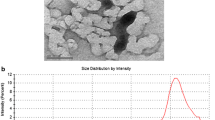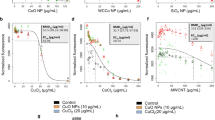Abstract
Iron oxide nanoparticles (FeNPs) are known to be one of the most biocompatible and safe nanoparticles. However, their long-term persistence remains a problem, and macrophages play as an important mediator in continuous stimulation of the immune system due to biopersistence of nanoparticles. In the present study, we identified the mechanisms underlying the uptake and toxicity of bare-FeNPs using RAW264.7 cells, a mouse peritoneal macrophage cell line. The bare-FeNPs penetrated the cell membrane through electrostatic interactions together with the general phagocytic pathway. At 24 h after exposure, they distributed freely in the cytosol or within autophagosome-like vacuoles. Bare-FeNPs induced decrease in the cell viability along with the cell cycle arrest in G1 phase. In addition, they increased the generation of ROS and the secretion of NO and TNF alpha as well as the expression of SOD-1 and SOD-2 proteins, which are an antioxidant. While the mitochondrial calcium level, the intensity of labeled mitochondria, and ATP production decreased, the levels of autophagy-related proteins such as p62, beclin 1, ATG5, and LC3B increased in a dose-dependent manner together with the levels of ATF 3, p-EGFR, and p-ERK proteins. However, the level of p-JNK protein clearly decreased. TEM images also showed that damaged organelle exist within autophagosome-like vacuoles with bare-FeNPs. On the basis of these results, we suggest that bare-FeNPs induce autophagy by initiating oxidative stress in RAW264.7 cells. Furthermore, ERK, but not JNK, pathway is activated in bare-FeNPs-induced autophagy.









Similar content being viewed by others
References
Buyukhatipoglu K, Clyne AM (2011) Superparamagnetic iron oxide nanoparticles change endothelial cell morphology and mechanics of reactive oxygen species formation. J Biomed Master Res A 96:186–195
Castaneda RT, Khurana A, Khan R, Daldrup-Link HE (2011) Labeling stem cells with ferumoxytol, an FDA-approved iron oxide nanoparticle. J Vis Exp 57:e3482
Chang L, Karin M (2001) Mammalian MAP kinase signaling cascades. Nature 410:37–40
Chen Y, Chen BA (2010) Application and advancement of magnetic iron-oxide nanoparticles in tumor-targeted therapy. Chin J Cancer 29:125–128
Davis RJ (2000) Signal transduction by the JNK group of MAP kinases. Cell 103:239–252
de Winther MP, van Dijk KW, Havekes LM, Hofker MH (2000) Macrophage scavenger receptor class A: a multifunctional receptor in atherosclerosis. Arterioscler Thromb Vasc Biol 20:290–297
Elias A, Tsourkas A (2009) Imaging circulating cells and lymphoid tissues with iron oxide nanoparticles. Hematology Am Soc Hematol Educ Progra 2009:720–726
Fan F, Jin S, Amundson SA, Tong T, Fan W, Zhao H, Zhu X, Mazzacurati L, Li X, Petrik KL, Fomace AJ Jr, Rajasekaran B, Zhan Z (2002) ATF3 induction following DNA damage is regulated by distinct signaling pathways and over-expression of ATF3 protein suppresses cells growth. Oncogene 21:7488–7496
Freeman M, Ashkenas J, Rees DJ, Kingsley DM, Copeland NG, Jenkins NA, Krieger M (1990) An ancient, highly conserved family of cysteine-rich protein domains revealed by cloning type I and type II murine macrophage scavenger receptors. Proc Natl Acad Sci USA 87:8810–8814
Gu J, Xu H, Han Y, Dai W, Hao W, Wang C, Gu N, Xu H, Cao J (2011) The internalization pathway, metabolic fate and biological effect of superparamagnetic iron oxide nanoparticles in the macrophage-like RAW264.7 cell. Sci China Life Sci 54:793–805
Gupta AK, Gupta M (2005) Synthesis and surface engineering of iron oxide nanoparticles for biomedical applications. Biomaterials 26:3995–4021
Hamdi M, Popeijus HE, Carlotti F, Janssen JM, van der Burgt C, Cornelissen-Steijger P, van de Water B, Hoeben RC, Matsuo K, van Dam H (2008) ATF3 and Fra1 have opposite functions in JNK- and ERK-dependent DNA damage responses. DNA Repair (Amst) 7:487–496
Hussain S, Al-Nsour F, Rice AB, Marshburn J, Yingling B, Ji Z, Zink JI, Walker NJ, Garantziotis S (2012) Cerium dioxide nanoparticles induce apoptosis and autophagy in human peripheral blood monocytes. ACS Nano 6:5820–5829
Inoue K, Zama T, Kamimoto T, Aoki R, Ikeda Y, Kimura H, Hagiwara M (2004) TNF alpha-induced ATF3 expression is bidirectionally regulated by the JNK and ERK pathways in vascular endothelial cells. Genes Cells 9:59–70
Kajanne R, Miettinen P, Mehlem A, Leivonen SK, Birrer M, Foschi M, Kahari V, Leppa S (2007) EGF-R regulates MMP function in fibroblasts through MAPK and AP-1 pathways. J Cell Physiol 212:489–497
Kakiashvili E, Dan Q, Vandermeer M, Zhang Y, Waheed F, Pham M, Szaszi K (2011) The epidermal growth factor receptor mediates tumor necrosis factor-alpha-induced activation of the ERK/GEF-H1/RhoA pathway in tubular epithelium. J Biol Chem 286:9268–9279
Kang YS, Sisbud S, Rabolt JF, Stroeve P (1996) Synthesis and characterization of nanometer-size Fe3O4 and γ-Fe2O3 particles. Chem Mater 8:2209
Kunzmann A, Andersson B, Thumherr T, Krug H, Scheynius A, Fadeel B (2011) Toxicology of engineered nanomaterials: focus on biocompatibility, biodistribution and biodegradation. Biochim Biophys Acta 1810:361–373
Laurent S, Boutry S, Mahieu I, Vander Elst L, Muller RN (2009) Iron oxide based MR contrast agents: from chemistry to cell labeling. Curr Med Chem 16:4712–4727
Lavicoli I, Leso V, Fontana L, Bergamaschi A (2011) Toxicological effects of titanium dioxide nanoparticles: a review of in vitro mammalian studies. Eur Rev Med Pharmacol Sci 15:481–508
Lee SJ, Pfluger PT, Kim JY, Nogueiras R, Duran A, Pagès G, Pouysségur J, Tschöp MH, Diaz-Meco MT, Moscat J (2010) A functional role for the p62-ERK1 axis in the control of energy homeostasis and adipogenesis. EMBO Rep 11:226–232
Ling D, Hyeon T (2013) Chemical design of biocompatible iron oxide nanoparticles for medical applications. Small 9(9–10):1450–1466
Lopez-Castro JD, Maraloiu AV, Delgado JJ, Calvino JJ, Blanchin MG, Galvez N, Dominguez-Vera JM (2011) From synthetic to natural nanoparticles: monitoring the biodegradation of SPIO (P904) into ferritin by electron microscopy. Nanoscale 3:4597–4599
Lu D, Chen J, Hai T (2007) The regulation of ATF3 gene expression by mitogen-activated protein kinases. Biochem J 401:559–567
Matsumoto A, Naito M, Itakura H, Ikemoto S, Asaoka H, Hayakawa I, Kanamori H, Aburatani H, Takaku F, Suzuki H, Kobari Y, Miyai T, Takahashi K, Cohenii EH, Wydroii R, Housman DE, Kodama T (1990) Human macrophage scavenger receptors: primary structure, expression, and localization in atherosclerotic lesions. Proc Natl Acad Sci USA 87:9133–9137
Naqvi S, Samim M, Abdin M, Ahmed FJ, Maitra A, Prashant C, Dinda AK (2010) Concentration-dependent toxicity of iron oxide nanoparticles mediated by increased oxidative stress. Int J Nanomedicine 5:983–989
Nebreda AR, Porras A (2000) P38 MAP kinases: beyond the stress response. Trends Biochem Sci 25:257–260
Nel AE, Madler L, Velegol D, Xia T, Hoek EM, Somasundaran P, Klaessig F, Castranova V, Thompson M (2009) Understanding biophysicochemical interactions at the nano-bio interface. Nat Mater 8:543–557
Park EJ, Kim H, Kim Y, Yi J, Choi K, Park K (2010) Inflammatory responses may be induced by a single intratracheal instillation of iron nanoparticles in mice. Toxicology 275:65–71
Platt N, Haworth R, Darley L, Gordon S (2002) The many roles of the class A macrophage scavenger receptor. Int Rev Cytol 212:1–40
Puppi J, Mitry RR, Modo M, Dhawan A, Raja K, Hughes RD (2011) Use of a clinically approved iron oxide MRI contrast agent to label human hepatocytes. Cell Transplant 20:963–975
Roitt IM, Brostoff J, Male DK (1985) Immunology. Gower Medical Pub.; C.V. Mosby, London; New York St. Louis
Schrand AM, Rahman MF, Hussain SM, Schlager JJ, Smith DA, Syed AF (2010) Metal-based nanoparticles and their toxicity assessment. Wiley Interdiscip Rev Nanomed Nanobiotechnol 2:544–568
Shon HK, Park J, Choi I, Park HM, Moon DW, Lee TG (2011) Mass imaging of iron oxide nanoparticles inside cells for in vitro cytotoxicity. J Nanosci Nanotechnol 11:638–641
Simonsen LO, Harbak H, Bennekou P (2012) Cobalt metabolism and toxicology-a brief update. Sci Total Environ 432:210–215
Song MM, Song WJ, Bi H, Wang J, Wu WL, Sun J, Yu M (2010) Cytotoxicity and cellular uptake of iron nanowires. Biomaterials 31:1509–1517
St Germain C, Niknejad N, Ma L, Garbuio K, Hai T, Dimitroulakos J (2010) Cisplatin induces cytotoxicity through the mitogen-activated protein kinase pathways and activating transcription factor 3. Neoplasia 12:527–538
Stern ST, Adiseshaiah PP, Crist RM (2012) Autophagy and lysosomal dysfunction as emerging mechanisms of nanomaterial toxicity. Part Fibre Toxicol 14:20
Subramaniam S, Unsicker K (2006) Extracellular signal-regulated kinase-as an inducer of non-apoptotic neuronal death. Neuroscience 138:1055–1065
Suzuki K, Doi T, Imanishi T, Kodama T, Tanaka T (1997a) The conformation of the alpha-helical coiled coil domain of macrophage scavenger receptor is pH dependent. Biochemistry 36:15140–15146
Suzuki H, Kurihara Y, Takeya M, Kamada N, Kataoka M, Jishage K, Ueda O, Sakaguchi H, Higashi T, Suzuki T, Takashima Y, Kawabe Y, Cynshi O, Wada Y, Honda M, Kurihara H, Aburatani H, Doi T, Matsumoto A, Azuma S, Noda T, Toyoda Y, Itakura H, Yazaki Y, Horiuchi S, Takahashi K, Kruijt JK, Van Berker T, Steinbrecher UP, Ishibashi S, Maeda N, Gordon S, Kodama T (1997b) A role for macrophage scavenger receptors in atherosclerosis and susceptibility to infection. Nature 386:292–296
Terada Y, Nakashima O, Inoshita S, Kuwahara M, Sasaki S, Marumo F (1999) Mitogen-activated protein kinase cascade and transcription factors: the opposite role of MKK3/6-p38 K and MKK1-MAPK. Nephrol Dial Transplant 14:45–47
Wang Y, Wang B, Zhu MT, Li M, Wang HJ, Wang M, Ouyang H, Chai ZF, Feng WY, Zhao YL (2011) Microglial activation, recruitment and phagocytosis as linked phenomena in ferric oxide nanoparticle exposure. Toxicol Lett 205:26–37
Yin N, Liu Q, Liu J, He B, Cui L, Li Z, Yun Z, Qu G, Liu S, Zhou Q, Jiang G (2013) Silver nanoparticle exposure attenuates the viability of rat cerebellum granule cells through apoptosis coupled to oxidative stress. Small 9(9–10):1831–1841
Zhao Y, Howe JL, Yu Z, Leong DT, Chu JJ, Loo JS, Ng KW (2013) Exposure to titanium dioxide nanoparticles induces autophagy in primary human keratinocytes. Small 9:387–392
Zhu MT, Feng WY, Wang Y, Wang B, Wang M, Ouyang H, Zhao YL, Chai ZF (2009) Particokinetics and extrapulmonary translocation of intratracheally instilled ferric oxide nanoparticles in rats and the potential health risk assessment. Toxicol Sci 107:342–351
Zhu XD, Zhuang Y, Ben JJ, Qian LL, Huang HP, Bai H, Sha JH, He ZG, Chen Q (2011) Caveolae-dependent endocytosis is required for class A macrophage scavenger receptor-mediated apoptosis in macrophages. J Biol Chem 286:8231–8239
Acknowledgments
We are very thankful to Bengt Fadeel, Karolinska Institute for helpful discussions. This work was supported by the Basic Science Research Program through the National Research Foundation of Korea funded by the Ministry of Education, Science, and Technology (2011-35B-E00011). Part of this work was also supported by National Research Foundation grant (2011-0019175) funded by the Korea government (MEST). In addition, M.H.C acknowledges the support of the Veterinary Research Institute of Seoul National University in Korea.
Conflict of interest
The authors report no conflicts of interest.
Author information
Authors and Affiliations
Corresponding authors
Electronic supplementary material
Below is the link to the electronic supplementary material.
204_2013_1134_MOESM1_ESM.ppt
EDS analysis of cell exposed to bare-FeNPs. (a) bright field and (b) dark field, and (d) EDS spectra of star point in TEM image (PPT 408 kb)
204_2013_1134_MOESM3_ESM.ppt
Decrease in pH following bare-FeNPs exposure. The pH value in cell culture media was measured within maximum 5 min after incubation finishing. The experiment was performed three times, independently, and the value means AV ± SD (PPT 263 kb)
Rights and permissions
About this article
Cite this article
Park, EJ., Umh, H.N., Kim, SW. et al. ERK pathway is activated in bare-FeNPs-induced autophagy. Arch Toxicol 88, 323–336 (2014). https://doi.org/10.1007/s00204-013-1134-1
Received:
Accepted:
Published:
Issue Date:
DOI: https://doi.org/10.1007/s00204-013-1134-1




